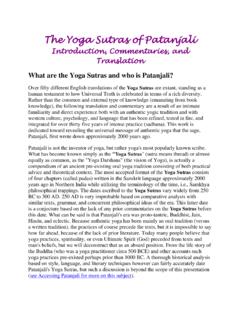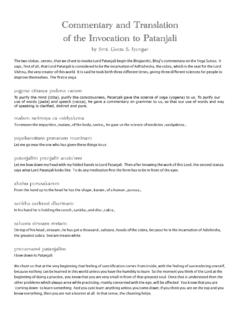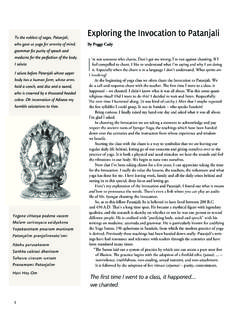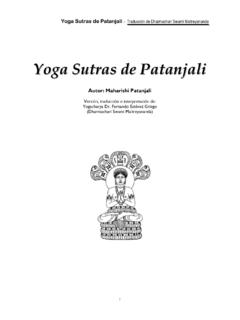Transcription of INSTITUTIONAL EQUITY RESEARCH Patanjali …
1 INSTITUTIONAL EQUITY RESEARCH Page | 1 | PHILLIPCAPITAL INDIA RESEARCH Patanjali Ayurved Ltd. A study in saffron INDIA | FMCG | Plant Visit Update 4 August 2016 Patanjali is a concept, quipped its public relations officer Mr Mishra when we visited Patanjali Ayurved Ltd s sprawling 170-acre plant (Unit 3) in Haridwar aptly named Padhartha (substance). The concept of Patanjali , based on the traditions of ayurveda, seemed ingrained in every person working there. While the company is still a work-in-progress, its direction and intentions are very clear. Patanjali is here to disrupt the FMCG market and it will do so in many categories.
2 The Indian FMCG industry, so far dominated by MNCs, is set to change and Patanjali will force the winds of this change for the better. Our key takeaways from the visit Large plants and aggressive expansion plans: Patanjali has set up a world-class manufacturing facility at its Unit 3 in Haridwar (the one we visited). Currently, it has three plants near Hairdwar Units 1, 2, and 3. Unit 3 is spread over 170 acres and was set up in 2009 under the government s Mega Food Park scheme. It manufactures products such as fruit juices, chyawanprash, aata, soaps, and various personal care products.
3 It provides employment to more than 10,000 people. The sheer scale of operations at the plant with mega godowns and conveyor belts clearly shows that the company has not taken any half measures in setting up its capacities. Patanjali owns 600 acres in Nagpur, where it will build more capacities. In addition, it plans to set up plants in Karnataka, Assam, and Madhya Pradesh all part of its plan to expand capacity and increase its manufacturing footprint. Strong belief in ayurveda and its efficacy; emphasis on quality: Every employee of Patanjali we met talks about the efficacy and benefits of ayurveda. They are convinced about the ayurveda s hidden treasures and the factory tour included sampling of ayuvedic herbs to demonstrate the product efficacy which was impressive.
4 This is perhaps the biggest differentiating factor for Patanjali its complete focus on ayurveda. Apart from this, there is lot of emphasis on product quality. While a lot needs to be done in this field, the company s mind-set is currently focused on quality and it is willing to forego volumes for quality. This is a significant strategic positive and indicates the company s long-term focus. Not fussed about margins; Sankalp (avowed) to achieve Rs 100bn turnover: From our interactions with top management, we gathered that the company is not particularly focused on margins at this stage, but rather on revenue growth.
5 Its employees have vowed to achieve a revenue target of Rs 100bn in FY17 from Rs 50bn in FY16. The management sounded confident but doubling revenues on a reasonably high base is a very tall order. Its biggest revenue drivers currently are ghee and toothpaste, but other food categories such as branded atta, masala, biscuits, and juices could drive substantial future revenues. Disruption in every category: Patanjali s broad strategy seems to be disruption in every category it is not P&L focused and has set up abundant capacities. With a very strong brand, differentiated positioning, and almost cult following, Patanjali has the capability to disrupt every category it enters.
6 On track to be a dominant force in the Indian FMCG industry: Patanjali currently has a product portfolio spanning 800 SKUS in 37 categories, and now competes with every major FMCG in one or more categories. In addition, it is consistently adding new categories and setting up new plants across India thereby broadening its manufacturing, customer, and revenue base. Currently, Patanjali has a reach of 200,000 outlets vs. 4mn for larger FMCGs; however, it is continuously expanding its reach by appointing new distributors. With the top management comprising majorly of visionaries, and middle and lower management recruited from top Indian/MNC FMCGs, the company is building the right human resource base for growth.
7 We believe that Patanjali has all the right ingredients to become a dominant force in the Indian FMCG industry in the medium term. NOT RATED Naveen Kulkarni, CFA, FRM (+ 9122 6667 9947) Jubil Jain (+ 9122 6667 9766) Page | 2 | PHILLIPCAPITAL INDIA RESEARCH Patanjali PLANT VISIT UPDATE Hygiene and quality State of the art factories, satisfactory hygiene: The personal care plant is highly automated. The mixing of raw materials, filling of tubes, and packaging of tubes into cardboard boxes is fully automated using very sophisticated machinery. Only after a set of 12 tubes is automatically wrapped in plastic sheets, is manual intervention required - to lift the tubes, place them into corrugated boxes and transport the boxes to warehouse for dispatch.
8 The atta plant and juices plant are also highly sophisticated with latest machinery. We observed that the workers on shop floor adhere to basic hygiene practices like wearing face masks, gloves, plastic caps and shoe covers, when required. Also, the floor in the factories is satisfactorily clean. The company maintains a warehouse of 100,000 sq. ft. to store 550 different kinds of herbs. It uses sophisticated technology to store and procure raw materials in the warehouse in towers, which are up to five storeys high. The hygiene in the warehouse is also satisfactory.
9 However, the company has scope to improve upon the hygiene on the roads outside the plant. We believe that with time, it would have the best systems and processes in place. Focus on quality: During production, quality checks are conducted on the shop floor every two hours to ensure that manufactured products are of the desired quality. Patanjali also has a state-of-the-art RESEARCH laboratory in Unit 3. It is dedicated to the advancement of the field of ayurveda. It houses various rooms for simulation of different environments to test the efficacy and life of its products. Experts recruited from RESEARCH teams of top FMCGs and experts ayurveda collaborate to produce new products and test them under stringent conditions.
10 It plans to spend additional Rs to set up a new RESEARCH laboratory near Haridwar. Page | 3 | PHILLIPCAPITAL INDIA RESEARCH Patanjali PLANT VISIT UPDATE Page | 4 | PHILLIPCAPITAL INDIA RESEARCH Patanjali PLANT VISIT UPDATE Financials Income Statement Y/E Mar, Rs mn FY12 FY13 FY14 FY15 Net sales 4,512 8,439 11,867 20,067 Growth, % 87 41 69 Other income 27 51 79 73 Total income 4,539 8,490 11,946 20,141 Raw material expenses 1,727 4,377 6,194 10.







